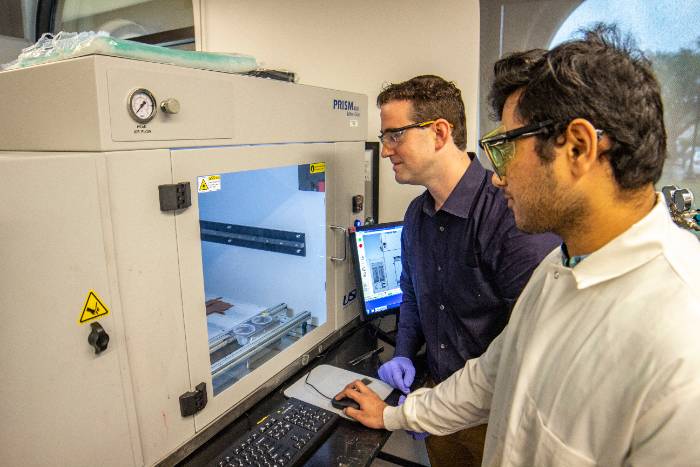LSU ChE Professors Arges, Romagnoli Use AI to Study Fuel Cells
March 9, 2020
 BATON ROUGE, LA – Though fuel cell technology has been studied by researchers worldwide
for the past 150 years, LSU Chemical Engineering Assistant Professor Chris Arges is
about to change the landscape of renewable energy. He recently received a $500,000,
two-year grant from the U.S. Department of Energy to optimize materials manufacturing
for fuel cells—environmentally friendly power sources, as they only emit water.
BATON ROUGE, LA – Though fuel cell technology has been studied by researchers worldwide
for the past 150 years, LSU Chemical Engineering Assistant Professor Chris Arges is
about to change the landscape of renewable energy. He recently received a $500,000,
two-year grant from the U.S. Department of Energy to optimize materials manufacturing
for fuel cells—environmentally friendly power sources, as they only emit water.
The project’s objective is to develop machine learning (ML) and artificial intelligence (AI) tools for accelerating the materials discovery, design, and processing for intermediate-temperature (200 °C) polymer electrolyte membrane fuel cells (IT-PEMFCs).
To be successful, Arges will generate large sets of data using unique high-throughput experimental methods (HTEM) in his lab. By partnering with LSU ChE Endowed Chair and Professor Jose Romagnoli (co-investigator), the ML/AI tools can then use the data for model development and optimization that will improve the performance and manufacturing of materials used in fuel cells. This project falls under the DOE Advanced Manufacturing Office’s plan to strengthen U.S. manufacturing competitiveness.
“The question is if we can generate materials’ property data where we can use computational tools to look at trends and develop good models that would guide the future design and processing of those materials,” Arges said.
Arges believes the fuel cell performance, cost and size can be improved by operating the fuel cell at higher temperatures. Although today’s low-temperature fuel cells are superior in terms of efficiency for converting fuel into work over internal combustion engines (50% versus 20%), they still generate waste heat that needs to be managed so that water in the membrane isn’t evaporated, leading to catastrophic failure of the fuel cell.
By moving to a high-temperature membrane that doesn’t require water, the fuel cell can operate at elevated temperatures, leading to better heat rejection and thus, potentially eliminating the need for a costly radiator that occupies space in the vehicle.
While some automotive manufacturers currently use fuel cell technology, it isn’t ready for primetime due to high costs and limited hydrogen refueling stations. Arges hopes to change that with his research.
“Fuel cell electric vehicle producers want to get rid of the ancillary units like the humidifier and radiator,” Arges said. “To do that, you need a higher temperature cell and proton-conducting membranes that conduct without water. That’s where our membrane research fits in.”
Arges and Romagnoli’s project has garnered support from membrane manufacturer Xergy, Los Alamos National Laboratory, 3M, and Toyota, the latter of which currently uses fuel cells in its Mirai vehicle.
Toyota plans to have a smaller fuel cell stack for its next fuel cell vehicle. Improving the fuel cell efficiency and reducing its size may enable the vehicle to drive 700 miles before refilling with hydrogen, alleviating the burden of building many hydrogen refueling stations.
Arges’ research could very well change the landscape as to how fuel cell materials are developed and manufactured.
“By developing ML/AI computational tools, it is posited that the timeline for improving IT-PEMFCs using advanced materials can be reduced from 15-20 years to 4-5 years,” he said. “Additionally, we keep discovering that there are a lot of other applications that these membranes are useful for, so we’re real excited to get this project rolling and to build off our previous successes.”
Like us on Facebook (@lsuengineering) or follow us on Twitter and Instagram (@lsuengineering).
###
Contact: Libby Haydel
Communications Specialist
225-578-4840